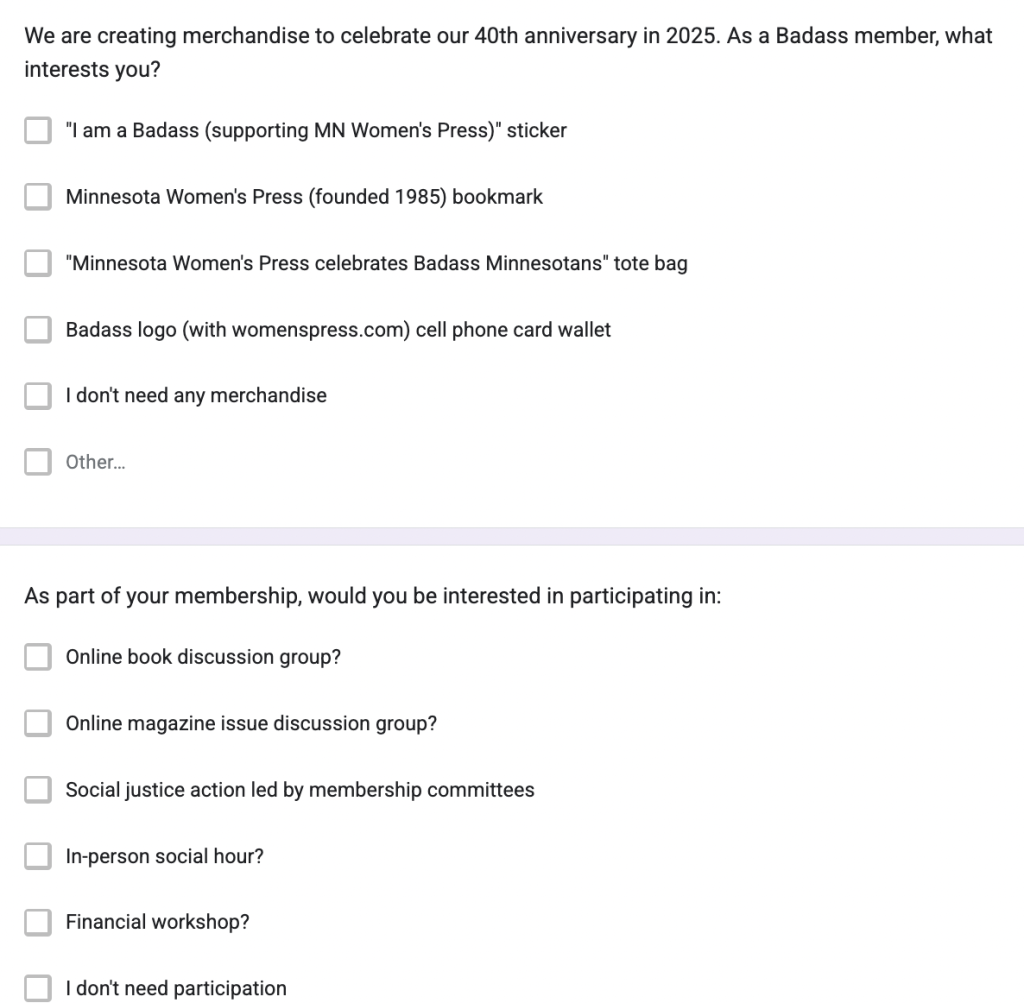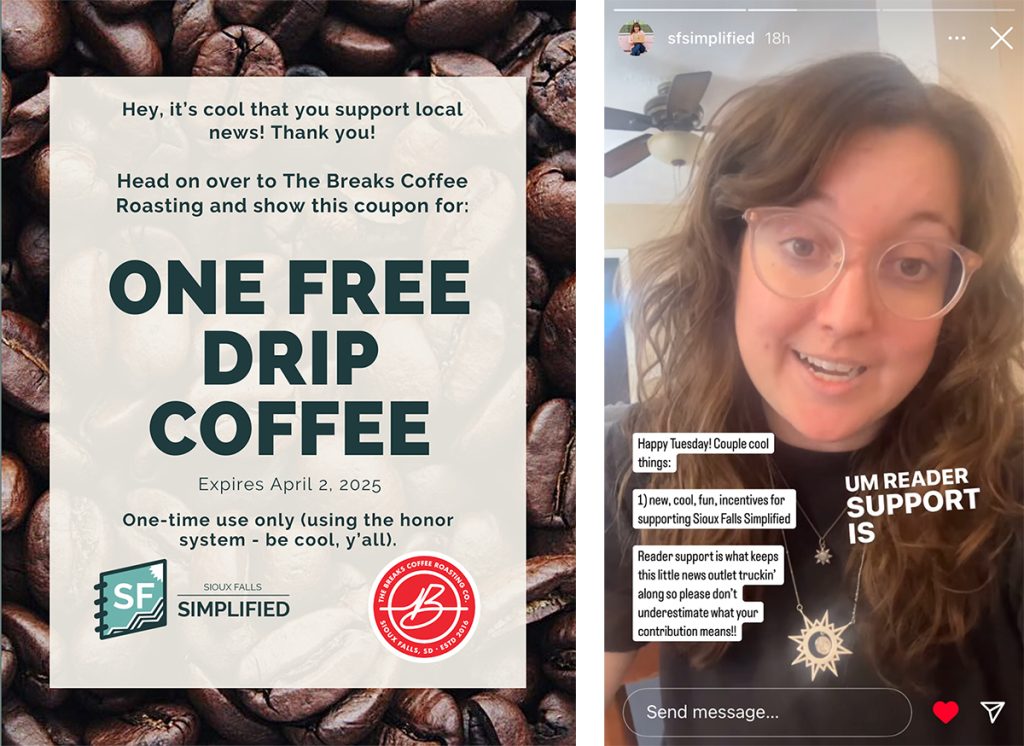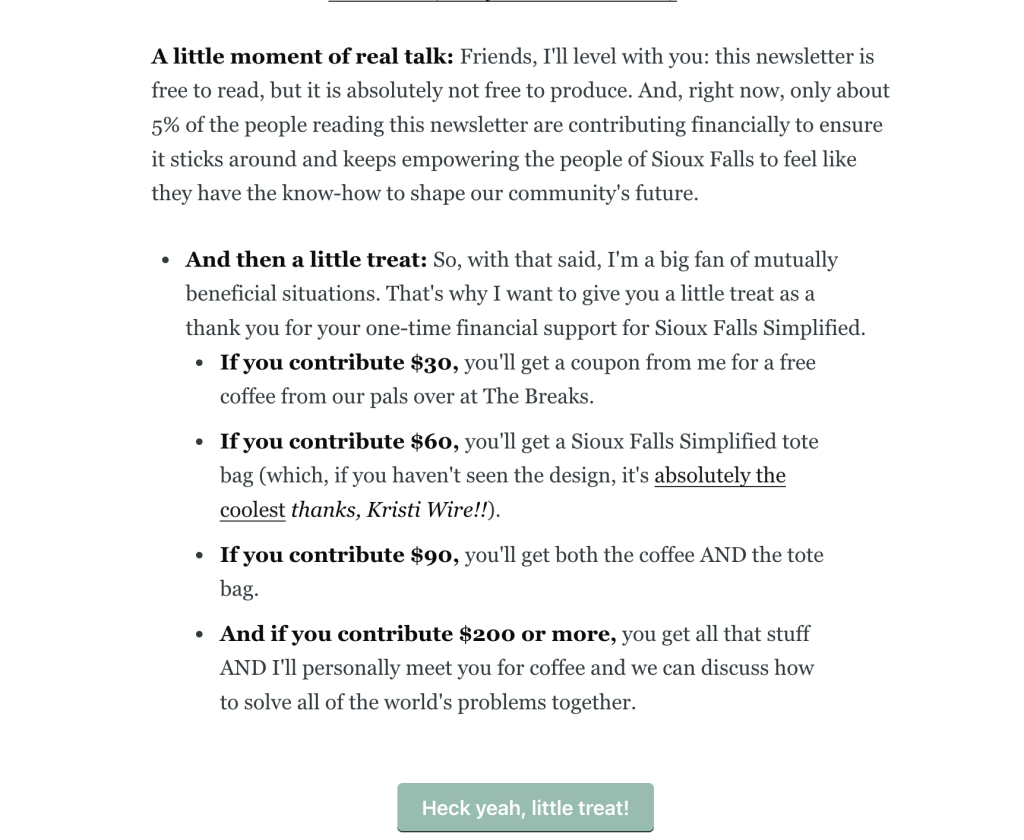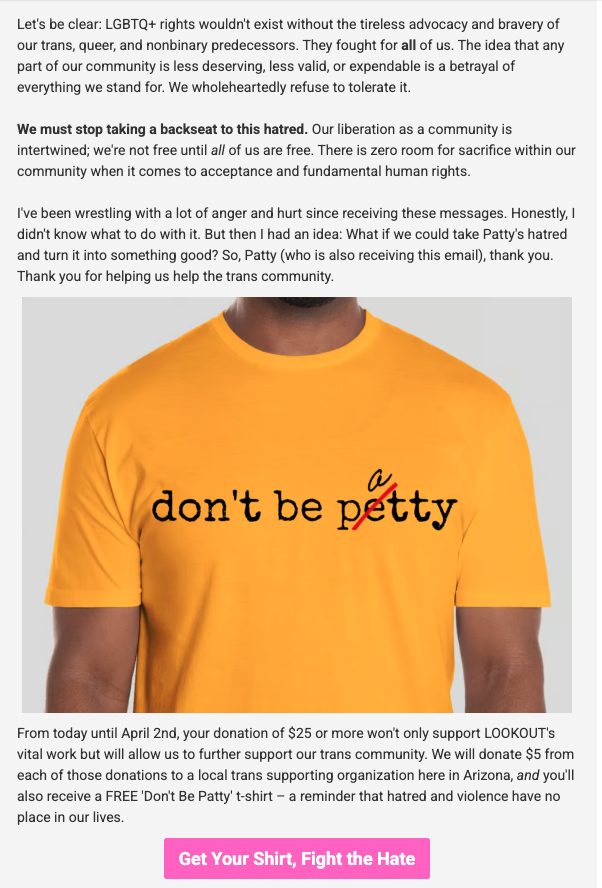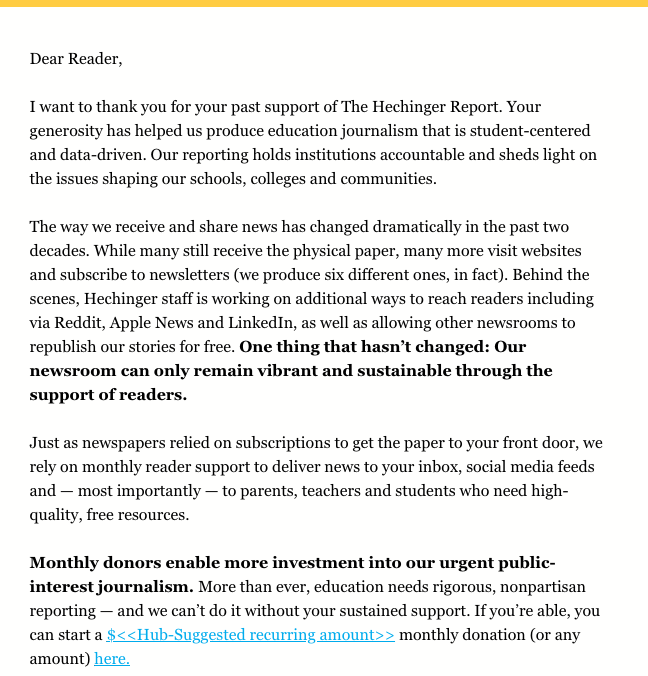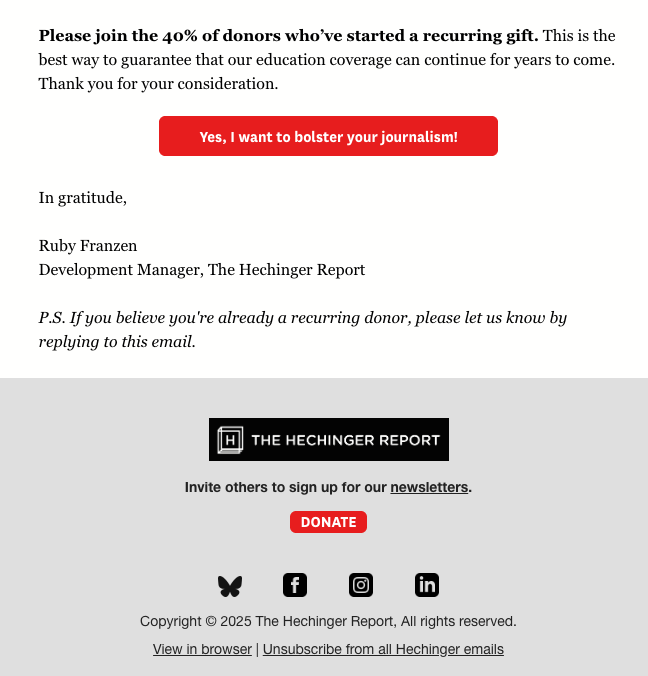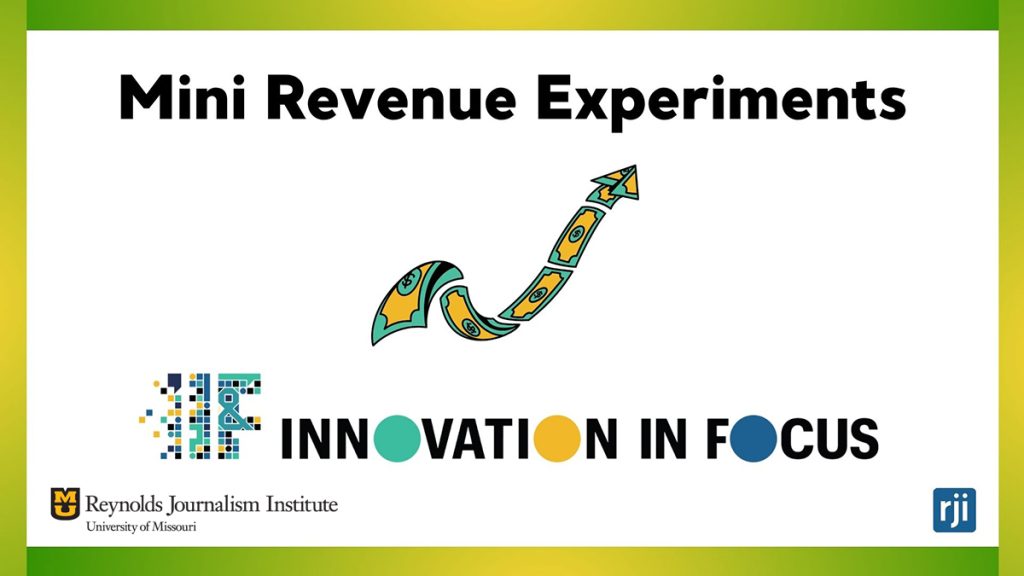
Four ways to break down large revenue goals into short-term experiments
From thank-you notes and swag to email strategies reaching specific audiences, what more than 20 newsrooms tested
Over the course of one month, we gathered more than 20 newsrooms to participate in a two-week revenue and fundraising experiment. While long-term planning is important, it can cause newsrooms to feel that they can’t try anything new without extensive funding and preparation. These experiments proved that we can glean valuable lessons, serve our communities and increase revenue from testing a new idea or strategy over a short period of time.
We split the experiments into four cohorts:
- Perks for Donating: Testing new and creative perks for our donors and/or subscribers.
- Creative ways to say thank you: Testing new ways to follow up and show donors the impact of their contribution — and thank them.
- Targeting specific audience segments: Testing how donation call-outs performed using pre-built or custom audience segments in an email platform.
- Registry-like donation page: Testing a page (or pages) where people can donate to specific causes/items (i.e. a tank of gas, camera equipment, an online subscription, etc.)
One common piece of feedback we heard from all four cohorts was that audiences were much more open to calls for donations or memberships than expected. They were often surprised by the level of engagement — and how few people unsubscribed — even when making multiple donation callouts in one month.
Since each newsroom modified the experiment to best fit their goals, we’ve captured a few highlights below.
Perks for donating
Designing campaigns focused on specific incentives — ranging from T-Shirts and totes to cups of coffee and vintage magazine issues — newsrooms in this cohort raised anywhere from $1,500 to $5,000.
These news organizations focused on comparing different incentives or using this information to learn more about how much perks play into people’s decision to donate. Even when their audiences didn’t seem significantly motivated by perks or swag, the participants in this cohort noted that branded totes or T-Shirts also helped with brand awareness and promotion for a longer-term strategy.
Minnesota Women’s Press ran a survey where they found, despite answers varying across demographics, that many people were interested in tote bags and online discussions about social issues. Minnesota Women’s Press plans to implement both these ideas.
At Sioux Falls Simplified Megan Raposa wanted to see how many Instagram users she could convert to donors. She ran a two-week experiment asking folks to make a one-time contribution in exchange for a choice of perks depending on their contribution: a cup of coffee at a local shop or a SFSimplified tote bag. She ultimately had 44 people donate for a total of $3,000 profit, excluding the $150-$200 in expenses.
She found that the one-time donation was a popular option for her audience, and many people chose the $60 level donation for a tote bag, which equates to an annual subscription.
At LOOKOUT, Jake Hylton turned a piece of hate mail into a catalyst for community support – and donations. When a reader (named “Patty”) responded to a recent newsletter with a divisive and hateful message about the trans and nonbinary community, LOOKOUT responded with an email campaign standing by their inclusive values. They quickly designed a T-Shirt with the words “Don’t be Patty (petty)” and offered it to anyone who donated $25 or more. They also committed to donating $5 from every donation to a local trans supporting organization.
Throughout LOOKOUT’s efforts throughout Arizona Gives Day, the nonprofit raised nearly $7,000 and donated $500 to Trans Spectrum of Arizona. (And they didn’t hear from Patty).
Creative ways to say “thank you”
While many people were in agreement that it’s hard to win the contest of “who has the coolest stuff to give away,” the news organizations in this group were able to try something related to building stronger relationships with their members or donors.
At Eugene Weekly, they invited members to an open house event at the newsroom that showed promise for greater attendance in the future.
The Chicago Reader partnered with a local business owner who gave his space (including open bar and appetizers) for an evening to host all of the Reader’s “Best of Chicago” winners and large donors, which the IRS defines as gifts $5,000 and above.
“It really showed our big donors why we matter and why we’re important and who loves us,” said Ellen Kaulig, chief of staff at the Chicago Reader. After the event, several people donated, even without direct asks, and one person inquired about joining the Reader’s board.
Also wanting to acknowledge donors outside of the digital space, Tradeoffs sent thank-you notes and some stickers to show appreciation and build a deeper relationship with donors. Kathryn Dugal at Tradeoffs said she received some messages from donors that they appreciated this new outreach, including photos of the stickers out in the real world.
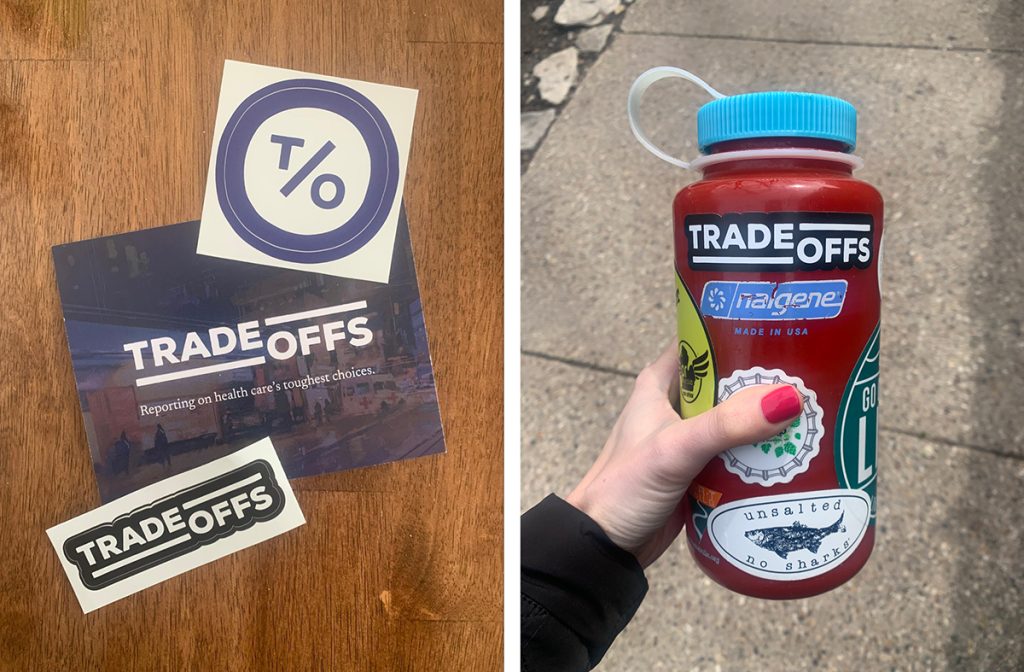
Targeting specific audience segments
Newsrooms in this cohort designed email campaigns to target specific audience segments, such as one-time donors or their most engaged audiences. While not every person saw large conversion rates, there were also unexpected lessons.
For example, Matt Sullivan at Spotlight Delaware noticed that most people who donated were folks who knew him personally or recognized him as a former newspaper columnist in the area. From this observation, Sullivan started to consider building a campaign around donors who are influencers in the community, getting testimonials about why they read and contribute.
Alyia Paulding at PublicSource similarly drew a helpful conclusion: They sent an email to more than 4,000 people with a high open rate and no unsubscribes. From this, Paulding was encouraged to send another email to this group since it appeared that they didn’t mind getting the ask, even if they weren’t ready to donate at that moment.
At the Poynter Institute, Jamese Branch sent a one-off fundraising email to subscribers of their flagship newsletter, Poynter Report. The email tested the same message on two segments: one of engaged Poynter Report subscribers as defined by Mailchimp (~30% of the total subscriber list) and one with all other subscribers.
In total, this round of the experiment raised more than $4,500. The engaged segment — despite being less than a third of the list — accounted for more than 80% of this total. The open and click rates for the engaged group were also twice or three times as high as that of the other group.
However, when Branch later scaled this experiment for Poynter’s entire audience, the most engaged group did not engage nor donate nearly as much. From this experiment, she plans to focus less on Mailchimp’s metrics and more on audience personas.
“When looking at Poynter’s full audience list, I’m dealing with fundamentally different user personas who engage with Poynter for varied reasons,” Branch wrote. “My theory is that Poynter’s audience is so diverse (ranging from college students who took a required course to simply pass a class to working professionals who want media news every day) that it makes sending a single message to our entire audience almost futile.”
At the Hechinger Report, Ruby Franzen segmented one-time donors, hoping to convert them to recurring monthly donors. She used the “suggested donation amount” calculation feature from News Revenue Hub to encourage one-time donors to start recurring monthly gifts. While Franzen did not see conversion from one-time to monthly, she did notice one-time to annual conversions with four total donations during the experiment. Next time, Franzen plans to run A/B tests with two different versions of language in the newsletter so they can better understand which is most effective for conversions.
Registry-like donation pages
The question driving the short-term experiment in this group was: Would people be more willing to donate if their donation was tied to a specific item?
Some of the ideas, included pay-what-you-can options (🔃) or specific prices (💰):
🔃 Freelance photographer — half day rate
🔃 A cup of coffee (with a source)
🔃 Travel
🔃 Photos for a story
🔃 A freelancer story
💰 A stack of notebooks
💰 Mic for undercover recording
💰 Hidden camera
💰 Dictaphone
💰 Tripod
🔃 Public records fees
💰 Software tools/hosting fees
💰 Satellite Internet
💰 Computer
💰 Camera
🔃 Social Media Manager
💰 Operational Costs (Internet, insurance, phone)
🔃 Legal fund
Many of the news organizations conducted A/B tests to learn a little more about which items or projects would most motivate people to subscribe, or if it made a difference at all. Multiple newsrooms in this cohort mentioned that it was difficult to attract people to a new or redesigned donation landing page, or they thought they would benefit from a more in-depth marketing/communication plan of the registry-like donation page.
For example, The Bureau of Investigative Journalism didn’t see any initial conversions from their new donation page built with DreamList. However, they did note some data from clicks: the most clicked options were ‘‘help us make videos” and “coffee with a source.” The team at the Bureau launched this campaign and site using their newsletter on Beehiiv. Rather than send this campaign to their entire list, the Bureau sent it to a segment that was highly engaged, and therefore they noticed a very low unsubscribe rate (0.18%).
At India Currents, they designed two separate donation pages each with a different set of wish lists. They did this all within the News Revenue Hub’s products, and unfortunately they did not have enough data to conclude which items had the greatest appeal to donors.
Benefits of diving in — even for just two weeks
While some news organizations raised as much as $5,000 during the two-week experiment and others only saw a couple of one-time donations, one thing was clear: Focusing on one small step to reach larger revenue goals is helpful.
For some newsrooms, these sprints prompted new ideas for experiments or A/B tests they want to pursue. For others, it was understanding better how their audience reacts to fundraising messages, or recognizing new opportunities for collaboration.
Do you have an idea for a short-term experiment related to revenue and fundraising? This was the first time we did the Mini Revenue Experiments, and we want to hear from you about what we should try next. Email Emily Lytle at lytle@rjionline.org.
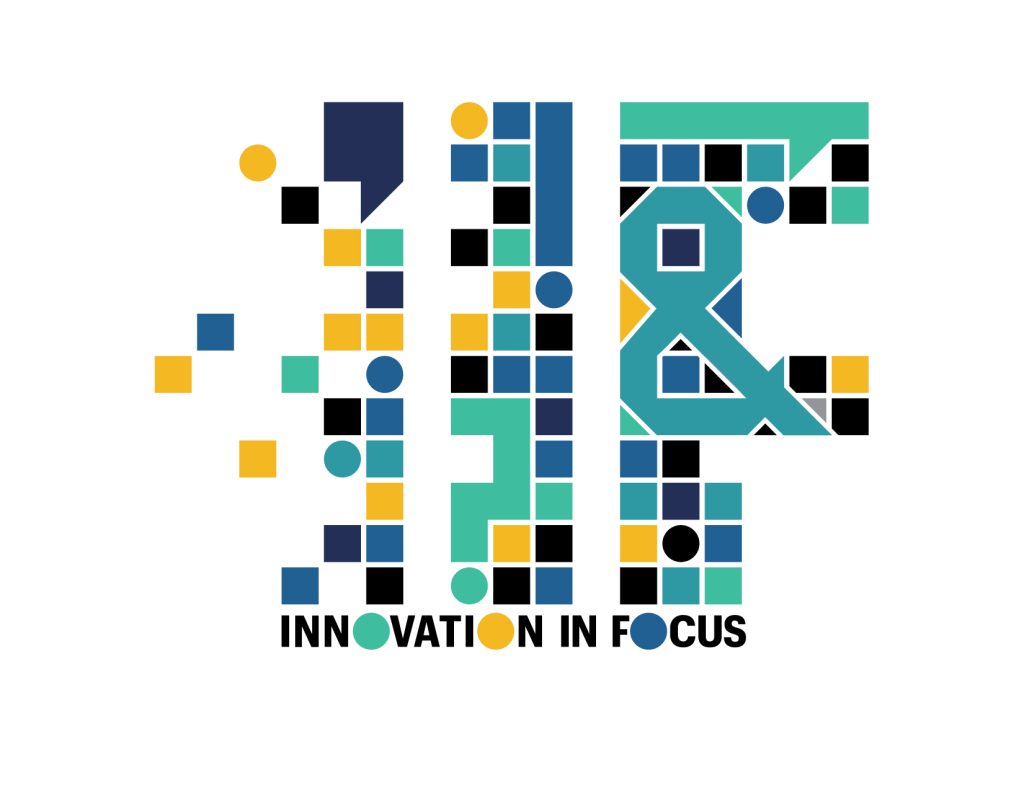
Sign up for the Innovation in Focus Newsletter to get our articles, tips, guides and more in your inbox each month!
Cite this article
Lytle, Emily (2025, May 29). Four ways to break down large revenue goals into short-term experiments. Reynolds Journalism Institute. Retrieved from: https://rjionline.org/news/four-ways-to-break-down-large-revenue-goals-into-short-term-experiments/

